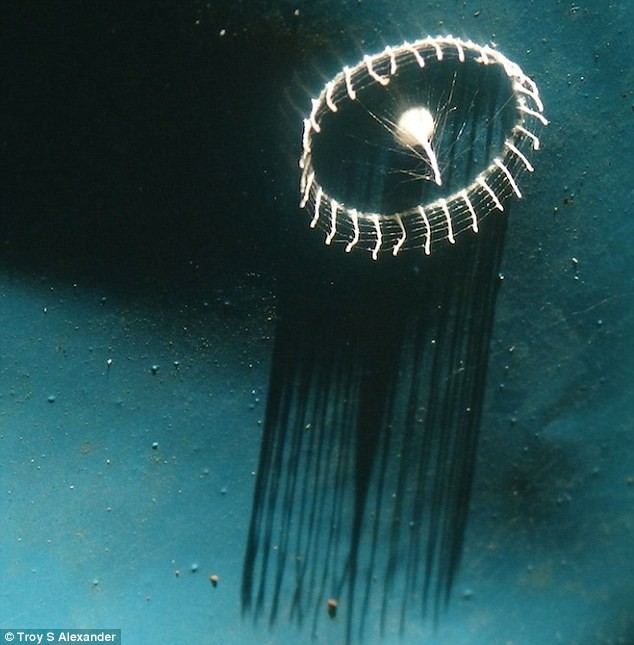Silkhenge Spider Species Lays A Single Egg, Then Protects It With A Picket Fence And Spire [VIDEO]

After six months, a mysterious sighting by a Georgia Tech graduate student in the Tambopata National Reserve in southeastern Peru has finally been explained. When a golden spider baby, about 0.2 millimeters across, emerged from a strange white spire on a tree in the Amazonian Rain Forest, entomologists knew they had found the answer to the mystery of "silkhenge."
Last June, Troy Alexander had spotted tiny, white, architectural structures on a Cecropia tree on a small island in the middle of a fish pond there. The structure included a firmly anchored white spire surrounded by what looked like a white picket fence, Alexander told Wired.com. To discover what the structures were, or which creature had made them, Alexander posted pictures on various entomological websites asking for answers. No one knew for certain, but many offered lots of different theories of who had formed them: slime mold, fungus, lacewings, human pranksters, and spiders.
Like Us on Facebook
Six months later, suspecting a Cribellate spider, ecologist Phil Torres, a PhD student at Rice University, who works with the Tambopata Research Center, led an eight-day expedition to find more of these structures. Accompanied by two entomologists from the University of Florida, and Amazon photographer Jeff Cremer, Torres set out for the rainforest. They trekked about 50 miles in canoe. "It's always exciting and exhausting working on these projects," he told International Science Times. "We would get dropped off on the flooded island at night and would tell the canoe drivers to return for us at midnight or 1 a.m. We spent hours and hours searching for any clue and attempting to find as many structures as possible. Because the origin of this structure was so unknown, we would take every observation down to see which of our theories it fit best with, and ran with it until that theory could no longer hold up."
Finally, in a 200-meter stretch of trail, expedition members discovered about 45 of the dainty architectural constructions, mostly on the Cecropias; some on bamboo; all on a little island in the middle of a fish pond. After three spiderlings crawled out of the bottom of three separate spires, they had their answer: Parent spiders were the architects. "We think they can build multiple structures, as we saw clusters of them in certain areas that we suspect were from the same female," Torres said. "We also don't know why it is made. Such an elaborate structure for a single egg comes with a high investment from the adult, it must have evolved for an adaptive purpose."
Unfortunately, the student who had first sited the configurations wasn't there to enjoy the discovery. "I knew Troy from working out there with him and was always impressed by his eye for odd little findings," Torres said. "He couldn't make it this time around. but will hopefully be involved in follow-up research. It was supposed to be a small side project as we were collecting data on another research project, but ended up dominating our time because we were so curious!"
"We're still attempting to identify the spider," Torres wrote in his blog. "There are several things that make this unusual." There only appeared to be a single egg per structure, making it "the only known occurrence of a spider laying a single egg per egg sac." It's also rare for spiders to abandon their eggs; almost all of them weave silken egg sacs into their webs the better to watch over them. Though Torres and his team saw a few adult spiders nearby, they have yet to see any spiders spinning the structures, "so construction and culprit remain a mystery," he wrote.
Torres and his team found that mites were on and in the structures and some even seemed to be trapped inside or along the eight millimeters in diameter fence of the structure, and other times crawling directly on the inner tower. "The fence most likely protects, but the idea of it capturing mites will be another fascinating hypotheses to follow up on," he told International Science Times. That the tower provides both protection for the spider egg and at the same time acts as a lure to mites is "very risky," he said, adding, "but it's all an equation of survival, and if the benefits outweigh the risks such a structure can be very helpful to fitness."
Torres hypothesized that the structure might in fact be designed to trap mites, to serve up as a first meal for a newly-hatched spider. He postulates the parent spider might cover the egg case with a chemical attractant to bait mites. "Chemical lures have been documented several times with spiders," he wrote. The fence may also do double-duty as a defense against ants. The silk could ensnare ants, and the distance from the center may prevent ants from easily detecting a food source within.
It looks like Torres will be pairing up the spiders to make more babies. "We plan more observations, rearing, and manipulations to see how they interact with their environment- like ants and mites," Torres said.
© 2012 iScience Times All rights reserved. Do not reproduce without permission.

25 Year Study Reveals Eco-Farming To Be Economically Feasible And Sustainable

How Methane-Producing Microbes Caused The Largest Mass Extinction The World Has Ever Seen

Terrifying Animatronic Robot Dances To 'Blurred Lines,' Causes Nightmares [VIDEO]

Scientists Demonstrate Three-Way Quantum Communication: What's Faster Than The Speed Of Light?

Woolly Mammoth DNA To Be Cloned, Then Joined With Elephant DNA To Create New Creature

Oculus Rift Headset Will Take You On A Trip To Space, All From The Comfort Of Your Couch



![How to Turn Your Tap Water Faucet Into a Coffee Spout [VIDEO]](../../../cdn-sub/data/thumb/mainpage/6005-150100-coffee.jpg)

